Are you looking for a trusted partner to turn your fragrance from concept into a show-stopping product?
In the world of perfumes, the bottle isn’t just a vessel—it’s the first buying decision. Today’s perfume bottle manufacturing goes beyond shape; it’s a strategic investment in marketing your product and elevating your brand’s position.
In this comprehensive guide from Jasmine Perfume & Fragrance Factory, we take you on a full-scope journey: from designing a bottle that reflects your brand, through precision manufacturing, all the way to professional filling that appeals to your end customer’s taste.
Whether you’re a retailer, distributor, or private-label owner, this article is crafted for you—so you can learn how to choose your bottle wisely and build a fragrance that sells before it’s even smelled.
Stay with us…
Why Perfume Bottle Design Is Essential for Product’s Success?
The perfume bottle serves as the first visual and emotional bridge between your product and the consumer. It’s not just a container for the fragrance; it’s a marketing tool and an expression of your brand’s identity and quality.
Here’s how the bottle drives your product’s success:
Captures the First Impression
The bottle creates the consumer’s initial visual impact, and often that alone sparks the purchase decision. Unique shapes, premium materials, and harmonious colors pique curiosity and convey value.
Reflects Your Brand Identity
Bottle design can mirror your brand’s philosophy—bold, elegant, natural, or luxurious. Through its form, your bottle communicates nonverbal messages that align perfectly with your marketing campaigns and brand positioning.
Enhances the User Experience
A bottle with a satisfying weight and tactile finish gives users a sense of luxury and attention to detail. The quality of the sprayer, the ease of use, and the stability of the cap all influence customer satisfaction and perceived product value.
Differentiates You from Competitors
In a crowded market flooded with thousands of bottles, a clever, well-executed design helps your product stand out and stay top of mind. A successful bottle becomes a visual icon that customers instantly associate with your fragrance—no label reading required.
Supports Your Pricing Strategy
An elegant bottle crafted from high-end materials justifies a higher price point, especially in the premium segment. Your bottle can elevate the fragrance from a mere beauty item into a collectible piece of art.
In short, a perfume’s success isn’t driven by its scent alone—the real commercial value lies in balancing fragrance and packaging, with the bottle serving as the gateway to love at first sight. Make sure your bottle speaks volumes beyond words.
Also read: Perfume Market Size in the Arab World: Real Statistics & Figures 2024
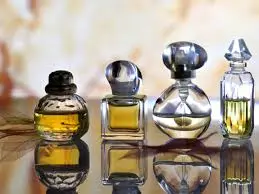
Types of Perfume Bottles
Perfume bottles can be categorized in various ways—by application method, material, external design, and capacity.
Here are the main types:
By Application Method
Spray Bottles
- They are the most common format.
- They offer precise dosing and prevent waste.
- They are equipped with a nozzle that disperses the fragrance as a fine mist.
Splash Bottles
- They are popular in traditional and classic men’s scents.
- They require extra care to avoid spillage or contamination.
- They are applied by pouring the fragrance directly onto the skin.
Roll-On Bottles
- They feature a rolling ball applicator for fragrance delivery.
- They are ideal for oil-based perfumes or targeted personal use.
Dropper Bottles
- They are used for concentrated or niche fragrances.
- They allow for precise drop-by-drop application, often favored for high-end sampling experiences.
By Material
Clear or Colored Glass
- Glass is the most commonly used material for preserving a fragrance’s chemical integrity.
- It conveys luxury and maintains the purity of the formula.
- It can be clear to showcase the perfume’s hue or coloured to protect it from light.
Crystal
- Used in high-end or limited-edition fragrances.
- It reflects light with a lavish sparkle and adds an artistic value to the bottle.
Acrylic or Plastic
- Employed in budget-friendly commercial perfumes or trial products.
- It’s lighter and less expensive but doesn’t offer the same premium feel as glass.
By Design
Classic
- Understated silhouettes and soft lines that emphasize elegance and simplicity.
Artistic/Designer Bottles
- Inspired by art, nature, or cultural motifs—these distinctive designs attract customers in search of something truly unique.
Functional
- Engineered for effortless handling, storage, and daily use, marrying practicality with sleek design.
By Capacity
- Small (5–15 ml): Ideal for travel and sampling.
- Medium (30–50 ml): The most popular size for personal purchase.
- Large (75–100 ml or more): Perfect for daily use or as a luxury gift.
Choosing the right perfume bottle isn’t just about the shape; it also involves technical aspects, design considerations, and consumer behavior. Understanding these categories helps you align your product with your target audience’s preferences and enhances both the sensory appeal and commercial value of the fragrance.
Also read: Perfume Aging: Best and Latest Methods
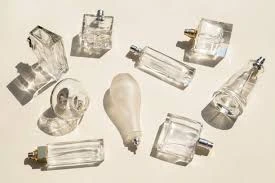
What is the manufacturing process of perfume bottles?
Create the impression before the cap is even lifted—the perfume bottle isn’t merely a container but the first thing your customer sees and the last thing they remember. Behind every elegant bottle lies a meticulous production journey that blends art with engineering, beginning with design sketches that tell a story and culminating in a glass piece pulsating with identity and value.
Below, we outline the key stages of the perfume bottle manufacturing process, from that initial spark of inspiration to a finished product worthy of pride on any retail shelf.
The creation of perfume bottles goes through several fundamental phases, from design to molding and final finishing, including
Bottle Design
The design phase is the most creative step, where you define
- Overall Shape (classic, geometric, artistic…)
- Nozzle Type (spray pump, dropper…)]
- Material (glass, crystal…)
3D CAD tools like AutoCAD or SolidWorks bring your concept to life.
Goal: Strike the perfect balance between visual appeal and functional performance.
Mold Making
- Precision metal molds are machined to match your approved design.
- Typically crafted from high-strength steel and produced on CNC equipment for exact tolerances.
- A single mold can produce thousands of bottles in automated production lines.
Glass Forming
- Raw materials (silica sand, sodium carbonate, calcium oxide) are melted in furnaces up to 1500 °C.
- The molten glass is then shaped in the mold using one of two methods:
- Hand Blown Glass: Ideal for luxury lines or artisanal batches.
- Machine Forming (Press-and-Blow / Blow-and-Blow): Optimized for high-volume manufacturing.
Gradual Cooling (Annealing)
- Bottles pass through an annealing oven to relieve internal stresses that could cause cracking.
- This stage takes 30–60 minutes, depending on glass thickness.
Surface Finishing
This phase includes:
- Polishing to remove imperfections and scratches.
- Scratch‐resistant treatments or UV printing.
- Glass coloring when required (clear, tinted, or metallic finishes).
Decoration
The brand logo or fragrance information is applied using:
- Silkscreen Printing
- Hot Stamping
- Laser Engraving
Decorative elements—such as metallic accents or crystal details—can also be added.
Final Assembly
- Other components are fitted: the sprayer, cap, and metal collar (if applicable).
- Spray performance, safety, and leak tests are conducted.
Quality Control
Each bottle is meticulously inspected to ensure:
- No bubbles or cracks in the glass
- Consistent color and print quality
- Conformance to mechanical specifications for spray performance and closure
Perfume-bottle manufacturing isn’t a random process but an interconnected system demanding high artistic and technical precision. A successful bottle shines not only through its beauty but in its suitability for the fragrance, its user experience, and its power to convey the scent’s identity and market position.
Also read: Jasmine Perfume Bottle Manufacturer & Supplier: Custom & Wholesale Solutions
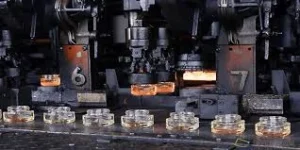
Quality & Safety Standards in Perfume Bottle Manufacturing
Ensure you implement rigorous quality and safety standards in perfume bottle production to guarantee a reliable, safe product that reflects your brand’s professionalism. These standards include:
- Raw-Material Purity: Use impurity-free glass to preserve the fragrance formula without chemical interactions.
- Break-and-Pressure Resistance: Test bottles to withstand transport and storage without cracking or leaking.
- Seal Integrity: Verify that the sprayer or cap prevents evaporation and spillage.
- Coating & Printing Safety: Employ non-toxic, durable materials that won’t transfer onto skin.
- Compliance with International Regulations: Adhere to ISO and REACH standards specific to perfume packaging.
Applying these criteria builds customer trust and demonstrates your brand’s commitment to quality—inside and out.
Also read: Safety Guidelines in Perfume Industry: Everything to Know
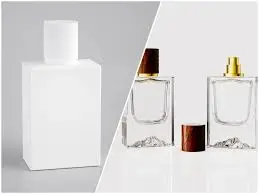
Jasmine: Premier Factory for Manufacturing & Filling Perfume Bottles
Elevate your fragrance brand to a new level of distinction with Jasmine—the leading wholesale empty perfume bottle supplier and the best name in manufacturing and selling perfume wholesale. We don’t just manufacture bottles; we embody your scent’s identity through refined design and quality that exceeds expectations.
With years of expertise and a network of over 70 agents worldwide, Jasmine Factory has become the top choice for brands seeking professionalism, precision, and a luxurious aesthetic in every detail.
Whether you’re launching your first fragrance or expanding your lineup, we partner with you to:
- Design and produce high-quality perfume and diffuser bottles.
- Handle filling and packaging to global standards.
- Fulfill bulk export orders quickly and efficiently.
Jasmine… where the aroma of success begins.
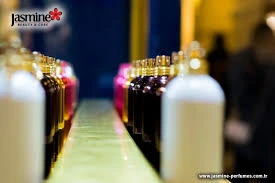
FAQs about Perfume Bottle Manufacturing
How are perfume bottles made?
Start by melting a blend of silica sand, sodium carbonate, and calcium oxide in a furnace at temperatures exceeding 1400 °C. Then shape the molten glass in custom metal molds using either blowing or pressing techniques. Next, cool the glass gradually in an annealing oven to prevent cracks, and finally apply finishing touches, printing, and decorative elements according to the design.
What material are perfume bottles made of?
Perfume bottles are typically crafted from high-purity soda-lime glass, chosen for its chemical stability and brilliant clarity, with options to tint or coat it with UV-protective layers. Luxury editions sometimes use crystal or tempered glass for added prestige.
How do I start a perfume business?
- Define your brand identity and target market.
- Develop fragrance formulations in partnership with experts or trusted suppliers.
- Select bottles and packaging that reflect your product’s quality.
- Set up a small filling line or partner with a dedicated filling factory.
- Obtain the necessary licenses and launch your marketing via distributors or online retail.
How much does it cost to manufacture a perfume?
Costs range from $2 to $15 per bottle, depending on quality and ingredients, roughly allocated as:
- Fragrance formulation: 30–50% of total cost
- Bottle and packaging: 20–40%
- Filling and assembly: 10–15%
- The remainder covers shipping, certification, and storage.
What Makes a Good Perfume Bottle؟
- An attractive, functional design that embodies the fragrance’s identity
- Pure glass that doesn’t interact with the formula
- Balanced weight imparting a sense of luxury
- Tight-sealing cap and reliable spray mechanism to prevent leaks
- Durability against breakage and ease of handling